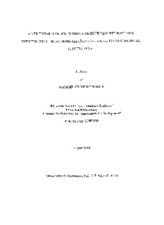| dc.creator | Sorice, Michael Gregory | |
| dc.date.accessioned | 2012-06-07T23:09:09Z | |
| dc.date.available | 2012-06-07T23:09:09Z | |
| dc.date.created | 2001 | |
| dc.date.issued | 2001 | |
| dc.identifier.uri | https://hdl.handle.net/1969.1/ETD-TAMU-2001-THESIS-S67 | |
| dc.description | Due to the character of the original source materials and the nature of batch digitization, quality control issues may be present in this document. Please report any quality issues you encounter to digital@library.tamu.edu, referencing the URI of the item. | en |
| dc.description | Includes bibliographical references (leaves 127-137). | en |
| dc.description | Issued also on microfiche from Lange Micrographics. | en |
| dc.description.abstract | Wildlife tourism can be problematic as managers are faced with the dual responsibility of developing products and programs for visitors while simultaneously protecting the resource. This study focused on encounters with the endangered West Indian manatee (Trichechus manatus) in Crystal River, Florida. The primary goal was to explore stakeholder perspectives on balancing the use of manatees as a recreational resource with their protection. Specific objectives were to (1) provide a descriptive account of the physical, social, and managerial setting; (2) understand the context in which decisions regarding harassment and negative impacts are made as well as their influence on the acceptability of manatee encounters; and (3) identify agreement, divergence and the resulting implications. Stakeholder perspectives on manatee encounters varied based on the benefits of allowing encounters (e.g., increased manatee protection constituency), the costs of potential negative impacts, and scientific evidence for negative impacts. These perspectives corresponded with each group's interpretation of formal policy prohibiting harassment. Groups with stricter interpretations tended to perceive physical contact as harassing, whereas other groups interpreted harassment as direct harm to the animal. The management of manatee encounters can be characterized as a "wicked problem." The problematization of encounters is not the result of scientific evidence; rather, it is an issue of divergent values. Consequently, there is no technical or "right" solution. The relationship between the Crystal River business community and the Crystal River National Wildlife Refuge was one of coexistence but is currently moving through the early stages of the conflict process. In order to move toward a symbiotic relationship, where both needs are satisfied, two conditions must be met: (1) the business community must willingly invest in manatee protection, and (2) management decisions on manatee encounters must incorporate stakeholder input. Planning processes, which have been successfully implemented to balance use and recreation in other settings (e.g., the Limits of Acceptable Change in wilderness areas), provide a proactive consensus-based management framework that can be tailored for decision-making regarding manatee encounters as well as other wildlife encounter settings. | en |
| dc.format.medium | electronic | en |
| dc.format.mimetype | application/pdf | |
| dc.language.iso | en_US | |
| dc.publisher | Texas A&M University | |
| dc.rights | This thesis was part of a retrospective digitization project authorized by the Texas A&M University Libraries in 2008. Copyright remains vested with the author(s). It is the user's responsibility to secure permission from the copyright holder(s) for re-use of the work beyond the provision of Fair Use. | en |
| dc.subject | recreation, park and tourism sciences. | en |
| dc.subject | Major recreation, park and tourism sciences. | en |
| dc.title | A multistakeholder perspective on human interactions with the West Indian manatee (Trichechus manatus) in Crystal River, Florida, U.S.A | en |
| dc.type | Thesis | en |
| thesis.degree.discipline | recreation park and tourism sciences | en |
| thesis.degree.name | M.S. | en |
| thesis.degree.level | Masters | en |
| dc.type.genre | thesis | en |
| dc.type.material | text | en |
| dc.format.digitalOrigin | reformatted digital | en |


